|
Sunday:
January 11, 2004 | |
0810 GMT |
 |
First rocket launch of 2004 has successful outcome
Riding the first space launch of 2004, a satellite dubbed the "Star of the South" successfully ascended into the sky Saturday night to relay communications for Brazil and other parts of the Americas.
 FULL STORY FULL STORY
 MISSION STATUS CENTER MISSION STATUS CENTER
 |  |

|
 |
Spirit rover stands up for its first drive
The Spirit Mars rover completed its multi-part "stand-up" sequence Saturday, the most complex set of mechanical deployments ever attempted by a robotic spacecraft. Resting on its now unfolded, locked-in-place undercarriage and its six ridged wheels, Spirit should be ready to roll off its lander and onto the martian surface by early Wednesday morning East Coast time to begin its long-await exploration of Gusev Crater.
 FULL STORY FULL STORY
 MISSION STATUS CENTER - updates! MISSION STATUS CENTER - updates!
 PREVIOUS MISSION COVERAGE PREVIOUS MISSION COVERAGE
 |  |
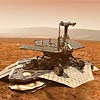
|
 |

Video coverage for subscribers only:
 VIDEO: SATURDAY'S BRIEFING ON ROVER STAND-UP ACTIVITIES QT VIDEO: SATURDAY'S BRIEFING ON ROVER STAND-UP ACTIVITIES QT
 VIDEO: LEARN MORE ABOUT FIRST MIN-TES INSTRUMENT IMAGES QT VIDEO: LEARN MORE ABOUT FIRST MIN-TES INSTRUMENT IMAGES QT
 VIDEO: FRIDAY'S SCIENCE AND ROVER STAND-UP BRIEFING QT VIDEO: FRIDAY'S SCIENCE AND ROVER STAND-UP BRIEFING QT
 SUBSCRIBE NOW SUBSCRIBE NOW

|
|
Saturday:
January 10, 2004 | |
0526 GMT |
 |
Sections of station to be cordoned off in leak search
The two-man crew aboard the International Space Station could be sequestered inside the Russian Zvezda module for several days beginning Wednesday as other portions of the orbiting complex are closed off to find a still-mysterious pressure leak.
 FULL STORY FULL STORY
 |  |
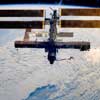
|
 |
|
Friday:
January 9, 2004 | |
0312 GMT |
 |
Reports: Bush to announce missions to moon and Mars
Various Washington news reports, citing unnamed sources, say President George W. Bush will make a revolutionary speech about the U.S. space program next week. The stories say voyages to the moon will resume, followed by the first human expedition to Mars.
 ASSOCIATED PRESS ARTICLE ASSOCIATED PRESS ARTICLE
 REUTERS ARTICLE REUTERS ARTICLE
 UPI ARTICLE UPI ARTICLE
 |  |

|
 |
Efforts continue to clear airbag from rover driveway
Engineers are having problems fully retracting partially collapsed airbags under the Spirit rover's landing platform that may hamper efforts to drive the vehicle straight off and onto the martian surface. Other exit routes are available, however, and mission manager Matt Wallace said he believed Spirit could simply drive over the airbag material with no problems.
 FULL STORY FULL STORY
 PHOTO: NEW COLOR IMAGERY PHOTO: NEW COLOR IMAGERY
 DOWNLOAD: HIGH-RES VERSION OF POSTCARD DOWNLOAD: HIGH-RES VERSION OF POSTCARD
 MISSION STATUS CENTER - updates! MISSION STATUS CENTER - updates!
 PREVIOUS MISSION COVERAGE PREVIOUS MISSION COVERAGE
 |  |

|
 |

Video coverage for subscribers only:
 VIDEO: EXPLORE THE NEW IMAGERY WITH EXPERT NARRATION QT VIDEO: EXPLORE THE NEW IMAGERY WITH EXPERT NARRATION QT
 VIDEO: THURSDAY'S SPIRIT HEALTH AND SCIENCE CONFERENCE QT VIDEO: THURSDAY'S SPIRIT HEALTH AND SCIENCE CONFERENCE QT
 VIDEO: WEDNESDAY'S SCIENCE AND ROVER STATUS BRIEFING QT VIDEO: WEDNESDAY'S SCIENCE AND ROVER STATUS BRIEFING QT
 SUBSCRIBE NOW SUBSCRIBE NOW

|
First rocket launch of 2004 to fly Saturday night
A new satellite to link Brazil with its northern neighbors is awaiting launch Saturday night from a platform anchored in the remote stretches of the tropical Pacific Ocean. Liftoff of the Estrela do Sul 1 communications spacecraft aboard the Sea Launch Zenit 3SL rocket is scheduled for 11:13 p.m. EST (0413 GMT).
 MISSION STATUS CENTER MISSION STATUS CENTER
 |  |

|
 |
Borax minerals may have been key to start Earth life
Astrobiologists, supported by NASA, have announced a major advance in understanding how life may have originated on Earth billions of years ago.
 FULL STORY FULL STORY
 |  |

|
 |
|
Thursday:
January 8, 2004 | |
0516 GMT |
 |
Mars Express mothership hears nothing from lander
To the despair of European space officials, the Mars Express orbiter has failed to detect a signal from the Beagle 2 lander Wednesday in the first opportunity for the mothership to establish communications with the baby craft that should have touched down on the Martian surface on Christmas Day.
 MISSION STATUS CENTER - updates! MISSION STATUS CENTER - updates!
 PREVIOUS COVERAGE PREVIOUS COVERAGE
 |  |
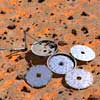
|
 |
Spirit's landing site more complex than first thought
More ultra-sharp views of the floor of Gusev Crater show a surprisingly rolling, rock-strewn landscape that bears little resemblance to the relatively smooth, wind-swept lakebed investigators thought they saw in initial, low-resolution images. Lakebed deposits may well be present, a mission scientist said Wednesday, but they may be more difficult to find than first thought.
 FULL STORY FULL STORY
 |  |

|
 |
Chandra locates planetary ore in colliding galaxies
NASA's Chandra X-ray Observatory has discovered rich deposits of neon, magnesium and silicon in a pair of colliding galaxies known as The Antennae. When the clouds containing these elements cool, an exceptionally high number of stars with planets should form. These results may foreshadow the fate of our Milky Way and its future collision with the Andromeda Galaxy.
 FULL STORY FULL STORY
 |  |

|
 |
Too fast, too furious: A galaxy's fatal plunge
Trailing 200,000-light-year-long streamers of seething gas, a galaxy that was once like our Milky Way is being shredded as it plunges at 4.5 million miles per hour through the heart of a distant cluster of galaxies. In this unusually violent collision with ambient cluster gas, the galaxy is stripped down to its skeletal spiral arms as it is eviscerated of fresh hydrogen for making new stars.
 FULL STORY FULL STORY
 |  |
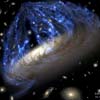
|
 |
|
Wednesday:
January 7, 2004 | |
0206 GMT |
 |
First color image from Spirit rover thrills scientists
The sharpest picture ever taken on the surface of Mars was unveiled Tuesday, a remarkably detailed color mosaic showing the rock-strewn vista directly in front of the Spirit rover that stretches all the way to misty mesas and hills on the distant horizon.
 FULL STORY FULL STORY
 MISSION STATUS CENTER - updates! MISSION STATUS CENTER - updates!
 OVERVIEW OF THE PANCAM OVERVIEW OF THE PANCAM
 PHOTOS: FIRST COLOR IMAGE PHOTOS: FIRST COLOR IMAGE
 PHOTOS: CLOSE-UP VIEW OF TERRAIN PHOTOS: CLOSE-UP VIEW OF TERRAIN
 PHOTOS: CLOSE-UP VIEW OF STREAKS IN SOIL PHOTOS: CLOSE-UP VIEW OF STREAKS IN SOIL
 PHOTOS: CLOSE-UP OF MARKS FROM AIRBAGS PHOTOS: CLOSE-UP OF MARKS FROM AIRBAGS
 DOWNLOAD: 4 MB FULL-RES COLOR IMAGE DOWNLOAD: 4 MB FULL-RES COLOR IMAGE
 |  |
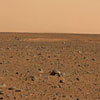
|
 |

Video coverage for subscribers only:
 VIDEO: EXPLORE THE COLOR IMAGERY WITH EXPERT NARRATION QT VIDEO: EXPLORE THE COLOR IMAGERY WITH EXPERT NARRATION QT
 VIDEO: TUESDAY'S IMAGERY AND ROVER STATUS NEWS CONFERENCE QT VIDEO: TUESDAY'S IMAGERY AND ROVER STATUS NEWS CONFERENCE QT
 MORE: COMPLETE MARS EXPLORATION ROVER VIDEO REPORT MORE: COMPLETE MARS EXPLORATION ROVER VIDEO REPORT
 SUBSCRIBE NOW SUBSCRIBE NOW

|
Space shuttle Columbia crew memorialized on Mars
NASA has announced plans to name the landing site of the Mars Spirit Rover in honor of the astronauts who died in the tragic accident of the space shuttle Columbia in February. The area in the vast flatland of the Gusev Crater where Spirit landed this weekend will be called the Columbia Memorial Station.
 FULL STORY FULL STORY
 |  |

|
 |
New search about to begin for Europe's Mars lander
A British spacecraft sent to the surface of Mars to look for evidence of past life has remained silent since its planned Christmas Day touchdown. On Wednesday, controllers will try a new tactic in their efforts to make contact with the Beagle 2 lander.
 MISSION STATUS CENTER - updates! MISSION STATUS CENTER - updates!
 PREVIOUS COVERAGE PREVIOUS COVERAGE
 |  |

|
 |
Stardust sailing through calm after cometary storm
"On January 2, comet Wild 2 gave up its particles but it did not do so without a fight," says Stardust project manager Tom Duxbury. "Our data indicates we flew through sheets of cometary particles that jostled the spacecraft and that on at least 10 occasions the first layer of our shielding was breached. Glad we had a couple more layers of the stuff."
 FULL STORY FULL STORY
 EARLIER COVERAGE EARLIER COVERAGE
 |  |

|
 |

Video coverage for subscribers only:
 VIDEO: TUESDAY'S POST-FLYBY ENGINEERING AND SCIENCE REPORT QT VIDEO: TUESDAY'S POST-FLYBY ENGINEERING AND SCIENCE REPORT QT
 VIDEO: STARDUST IMAGES PRODUCE THIS MOVIE OF COMET FLYBY QT VIDEO: STARDUST IMAGES PRODUCE THIS MOVIE OF COMET FLYBY QT
 VIDEO: SIMULATION OF IMPACTS THAT STARDUST SUSTAINED QT VIDEO: SIMULATION OF IMPACTS THAT STARDUST SUSTAINED QT
 SUBSCRIBE NOW SUBSCRIBE NOW

|
|
Tuesday:
January 6, 2004 | |
0326 GMT |
 |
Spirit shows Mars in 3D
A 3D panorama shot by Spirit's low-resolution navigation cameras was unveiled Monday and a full-resolution, color mosaic showing the terrain immediately in front of the rover is scheduled for downlink early Tuesday.
 FULL STORY FULL STORY
 PHOTOS: 3D PANORAMA UNVEILED PHOTOS: 3D PANORAMA UNVEILED
 DOWNLOAD: SEE THE FULL 3D PAN DOWNLOAD: SEE THE FULL 3D PAN
 |  |

|
 |

Video coverage for subscribers only:
 VIDEO: RELIVE THRILL OF LANDING NIGHT IN HIGHLIGHTS MOVIE QT VIDEO: RELIVE THRILL OF LANDING NIGHT IN HIGHLIGHTS MOVIE QT
 VIDEO: MONDAY'S SPIRIT ROVER AND IMAGERY STATUS BRIEFING QT VIDEO: MONDAY'S SPIRIT ROVER AND IMAGERY STATUS BRIEFING QT
 VIDEO: MEET MEMBERS OF THE MISSION CONTROL "DREAM TEAM" QT VIDEO: MEET MEMBERS OF THE MISSION CONTROL "DREAM TEAM" QT
 SUBSCRIBE NOW SUBSCRIBE NOW

|
Suns of all ages possess comets, maybe planets
When Comet Kudo-Fujikawa zipped past the Sun at a distance half that of Mercury's orbit last year, astronomers were watching. They observed the comet puffing out huge amounts of carbon, one of the key elements for life. The comet also emitted large amounts of water vapor as the Sun's heat baked its outer surface.
 FULL STORY FULL STORY
 |  |

|
 |
Hubble tells tale of record-breaking galaxy clusters
An international team of astronomers, looking back in time, has found embryonic galaxies a mere 1.5 billion years after the birth of the cosmos, or 10 percent of the universe's present age. The "baby galaxies" reside in a still-developing cluster, the most distant proto-cluster ever found.
 FULL STORY FULL STORY
 |  |

|
 |
Young star caught speeding
Astronomers have caught a newly formed star in the act of speeding. PV Ceph, located about 1400 light years away in the constellation Cepheus, is whizzing through space at a speed of 40,000 miles per hour -- some 40 times faster than a speeding bullet. And like a bullet, it left an exit wound when it ripped out of the star cluster where it formed.
 FULL STORY FULL STORY
 |  |
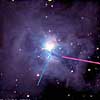
|
 |
|
Monday:
January 5, 2004 | |
0705 GMT |
 |
Spirit's high-gain antenna successfully deployed
In another major milestone, the Spirit Mars rover's high-gain antenna was successfully deployed Sunday night and aimed at Earth. A few minutes before 12:30 a.m. EST Monday, the first direct-to-Earth communications session over the high-data-rate antenna began, prompting a now-familiar round of cheers and applause in mission control.
 FULL STORY FULL STORY
 SOL 2 PREVIEW STORY SOL 2 PREVIEW STORY
 SPIRIT LANDS IN SCIENCE 'SWEET SPOT' SPIRIT LANDS IN SCIENCE 'SWEET SPOT'
 |  |

|
 |

Video coverage for subscribers only:
 VIDEO: SUNDAY BRIEFING ON SPIRIT'S HEALTH AND LANDING SITE QT VIDEO: SUNDAY BRIEFING ON SPIRIT'S HEALTH AND LANDING SITE QT
 VIDEO: TAKE SIMULATED FLIGHT OVER THE GUSEV CRATER! QT VIDEO: TAKE SIMULATED FLIGHT OVER THE GUSEV CRATER! QT
 VIDEO: BEHIND THE SCENES AT MOMENT OF TOUCHDOWN QT VIDEO: BEHIND THE SCENES AT MOMENT OF TOUCHDOWN QT
 VIDEO: CHEERS AND SCREAMS WHEN SPIRIT CONFIRMED ALIVE QT VIDEO: CHEERS AND SCREAMS WHEN SPIRIT CONFIRMED ALIVE QT
 MORE: COMPLETE MARS EXPLORATION ROVER VIDEO REPORT MORE: COMPLETE MARS EXPLORATION ROVER VIDEO REPORT
 SUBSCRIBE NOW SUBSCRIBE NOW

|

